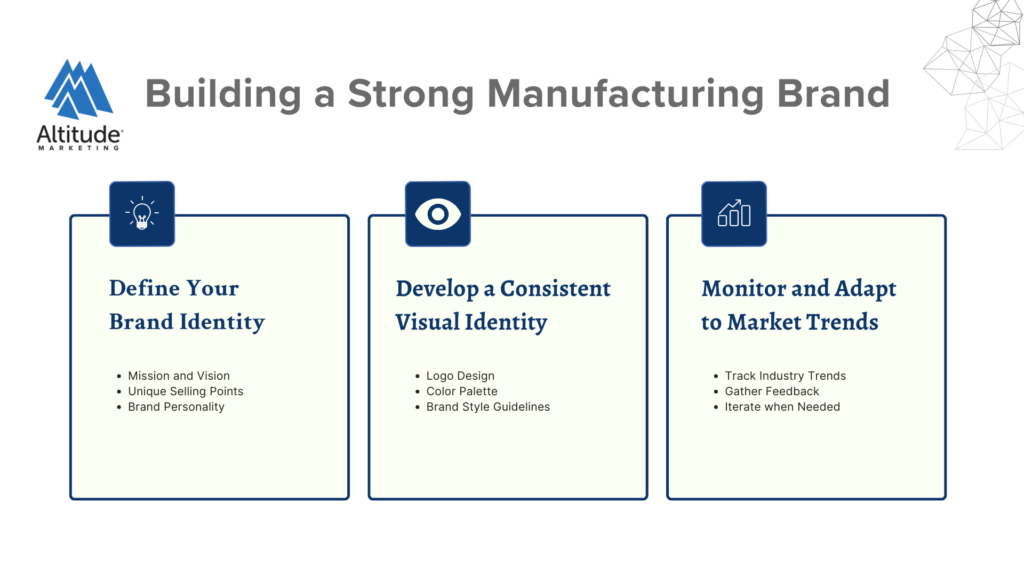Manufacturers build. It’s a bit ironic then that many–perhaps because they are so focused on the products and services they provide–neglect to build one of the foundational elements of their business. Their brand.
B2B manufacturers live in an incredibly technical space–specializing in products and processes seen nowhere else in the world. But the benefits of having a good brand aren’t any different than more mainstream companies. A brand is your foundation. The best ones elicit experience, trust, and authority. A good brand allows good marketing to follow. That, of course, then leads to good business growth.
You already know how to build. Now, make sure some of that energy goes toward your manufacturing brand. These three tips will get you started.

How to Build a Strong Manufacturing Brand
Step 1: Define Your Brand Identity

Every great brand starts with an identity. It serves as the guiding rail to every marketing element to follow. Your identity needs to be consistent, clear, simple, and attractive to your target audience. To build a lasting identity, you need to focus on three elements:
A. Your Mission and Values Statement
This isn’t just who you are. It’s the “why” in what you do. This statement encapsulates the overarching purpose and principles that guide your company’s operations and decision-making processes. By articulating a clear mission statement that communicates your company’s core objectives and values, you not only align your internal team on a common purpose, you set a stake in your industry’s ground. A well-defined mission and values statement n serves as a beacon that attracts like-minded customers and stakeholders who align with your company’s ethos and aspirations.
B. Your Unique Selling Proposition (USP)
Why are you great? The Unique Selling Proposition (USP) should concisely answer this question. Your USP is what sets your manufacturing brand apart from competitors and provides a compelling reason for customers to choose your products over alternatives. Whether it’s superior quality, innovative technology, sustainable practices, or exceptional customer service, your USP should highlight the distinctive benefits that your brand offers to customers. By clearly articulating your USP, you not only capture the attention of your target audience but also foster brand loyalty and advocacy by delivering on the promises that set your brand apart.
C. Personality and Tone of Voice
Just as individuals have distinct personalities that shape how they interact with others, brands also have unique personalities that define their communication style and relationship with consumers. Defining your brand’s personality involves identifying traits and characteristics that resonate with your target audience and align with your brand values. Whether your brand exudes warmth and approachability, sophistication and elegance, or ruggedness and authenticity, consistency in portraying your brand personality across all touchpoints is essential for building trust and forging emotional connections with customers. Additionally, establishing a consistent tone of voice ensures that your brand communication remains cohesive and recognizable, whether it’s through marketing materials, customer interactions, or social media marketing.
By infusing your brand and marketing tools with a distinct personality and tone of voice, you create a memorable and relatable identity that resonates with your audience and distinguishes your business from others.
Develop a Consistent Visual Identity
Visual identity can distinguish your brand from competitors. Ensuring an easy-to-recognize visual identity can further promote brand recognition and increase brand awareness. Start with these three elements:
A. Logo Design and Variation
Your logo is the visual centerpiece of your brand identity, serving as a symbol that represents your company’s values, personality, and offerings. When designing your logo, consider elements such as simplicity, memorability, and versatility to ensure it can effectively communicate your brand message across various mediums and platforms.
Additionally, incorporate relevant imagery, symbols, or typography that resonate with your target audience and align with your brand identity.
For example, car manufacturers like Toyota can be recognized for their simple yet elegant logos.
Beyond the logo, establish consistent branding elements such as icons, patterns, or graphics that reinforce your brand identity and create a cohesive visual language across all touchpoints.
B. Color Palette and Typography
The choice of colors and typography plays a crucial role in shaping the visual identity of your brand and evoking specific emotions and associations among your audience. Select a color palette that reflects your brand’s personality and values while considering factors such as cultural connotations and psychological impact. Whether opting for bold and vibrant hues or muted and understated tones, ensure consistency in using your chosen colors across all brand assets and materials. Similarly, choose typography that complements your brand aesthetic and enhances readability.
C. Brand Style Guidelines
Developing comprehensive brand style guidelines is essential for maintaining consistency and cohesion in your visual identity.
This should be employed throughout all brand communication efforts and any strong marketing strategy. From email marketing, social media channels, and content marketing, using these visual tells ensures marketing success.
These guidelines outline rules and specifications for logo usage, color schemes, typography, imagery, and other visual elements to ensure uniformity across all brand assets and marketing strategy materials.
Brand style guidelines empower internal teams, external partners, and stakeholders to maintain brand consistency and integrity in their respective roles by providing clear instructions and examples. They also entice prospective customers to engage with your brands on social media platforms.
Adherence to brand style guidelines reinforces marketing objectives and strengthens the overall brand identity in consumers’ eyes. Whether designing promotional materials, creating digital content, or developing packaging designs, using these in marketing campaigns is a must.
Regularly review and update these guidelines to accommodate changes in brand strategy, market trends, and design standards, ensuring that your visual identity remains fresh and consistent with current trends.
Monitor and Adapt to Market Trends
Change is inevitable. Even the largest companies on earth refresh and adapt their logo–Google has done it six times in three decades. On a yearly basis, follow these three steps to make sure your brand continues to have a relevance.
A. Track Industry Trends and Market Shifts
Staying abreast of industry trends and market shifts is imperative for manufacturing brands to remain competitive and responsive to evolving consumer preferences and market dynamics. This involves actively monitoring changes in technology, regulations, consumer behavior, and competition within the manufacturing sector. By leveraging market research, industry reports, and data analytics, manufacturers can identify emerging trends, anticipate shifts in demand, and capitalize on new opportunities for innovation and growth.
B. Gathering Feedback from Customers and Stakeholders
Engaging with existing customers and stakeholders on an ongoing basis is essential for manufacturers to understand their needs, preferences, and pain points, and to gather actionable feedback for continuous improvement.
Implementing feedback mechanisms such as surveys, focus groups, customer interviews, and online reviews allows manufacturers to solicit valuable insights directly from the source. By actively listening to customer feedback and incorporating their suggestions into your brand, manufacturers demonstrate their commitment to customer satisfaction and loyalty.
C. Iterating and Evolving Brand Strategies as Needed
Manufacturing brands need to embrace a culture of continuous learning, experimentation, and adaptation. This is to stay relevant and resilient over time.
This involves regularly evaluating and refining brand strategies in response to changing market conditions, consumer preferences, and competitive pressures. Whether it’s adjusting product offerings, refining marketing tactics, or realigning brand messaging, manufacturers must be agile and proactive in responding to emerging trends and seizing new opportunities. By embracing innovation, flexibility, and a willingness to challenge the status quo, manufacturing brands can position themselves for long-term success and sustainable growth.
Frequently Asked Questions
How can small manufacturing businesses present as a larger brand?
Small manufacturing businesses can compete with their larger counterparts by leveraging their unique strengths and focusing on niche markets or specialized products. By emphasizing attributes such as quality, craftsmanship, innovation, and personalized customer service, small manufacturers can differentiate themselves from larger competitors. Additionally, leveraging digital marketing channels, building strategic partnerships, and cultivating a strong brand narrative can help small manufacturers amplify their presence and compete effectively in the marketplace.
What role does storytelling play in manufacturing brand building?
Storytelling plays a crucial role in manufacturing brand building by humanizing the brand, creating emotional connections with customers, and conveying its values, heritage, and commitment to excellence. By sharing compelling stories about their origins, craftsmanship, innovation journey, or impact on communities and the environment, manufacturers can engage and inspire audiences, differentiate themselves from competitors, and build brand loyalty. Effective storytelling helps manufacturers establish authenticity, credibility, and resonance with their target audience, driving brand awareness and affinity over time.
How can manufacturers measure the success of their branding efforts?
Manufacturers can measure the success of their branding efforts through various key performance indicators (KPIs) and metrics that align with their brand objectives and business goals. These may include metrics such as brand awareness, brand sentiment, customer engagement, website traffic, social media reach, conversion rates, customer satisfaction scores, and return on investment (ROI) from branding initiatives. By tracking and analyzing these metrics regularly, manufacturers can gain insights into the effectiveness of their branding strategies, identify areas for improvement, and make data-driven decisions to optimize their brand performance and drive business growth.
Conclusion: A Solid Foundation Starts With a Solid Brand
From defining your brand identity and communicating core values to developing a consistent visual identity and monitoring market trends, each stage plays a crucial role in shaping how consumers and stakeholders perceive your brand.
By focusing on differentiation, authenticity, and customer-centricity, manufacturers can establish a compelling brand presence that resonates with their target audience and sets them apart in a competitive marketplace.
It’s essential to recognize that brand building is not a one-time effort but an ongoing process that requires continuous attention. Great marketing–and thus great results–only come from a solid brand. So make sure you invest the time and resources needed to build yours with the same quality and craftmanship you use to build your core products.




